

Upon viewing the Capitol Complex in Charleston, one is left with little doubt that the seat of government in West Virginia is securely moored along the north bank of the Kanawha River. Yet, the capitol's location literally floated between the northern and south-central regions of the Mountain State during its spirited one hundred nineteen-year history. During the first twenty years of what could be considered a turbulent period of new statehood, West Virginia grew in population and watched her people gather and shift with the economic tides of industrialization. At the same time, power structures emerged in the developing cities, and the establishment of a permanent seat of government became the political chess piece of the era. The temporary seat of government was located at Wheeling, where statehood was deliberated and finally determined on June 20, 1863. Washington Hall, the site of numerous meetings and assemblies concerning the proposed 35th state, is now popularly known as "The Birthplace of West Virginia."
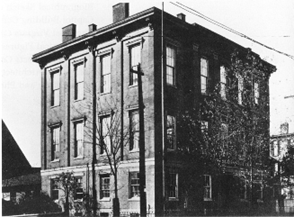
Linsly Institute Building in Wheeling; the first state capitol.
The first official Capitol Building, however, was the Linsly Institute building, erected in 1858. This site served as the capital of West Virginia for seven years, until the Legislature selected Charleston as the "permanent" seat. On March 28,1870, state officials met at the levee in Wheeling to board The Mountain Boy, a steamer laden with state records and other properties, to make the journey down the Ohio River and up the Great Kanawha to the new capital city.
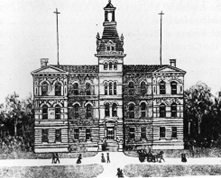
Artist's rendering of the first Charleston capitol.
The first Charleston Capitol was built in 1869-70 by the State House Company, a corporation headed by Dr. John P. Hale, a prominent Charleston physician and historian. Located at Capitol and Lee Streets in downtown Charleston, it remained the State Capitol until the Legislature elected to return the seat of government to Wheeling in May of 1875. State officials again made the journey (May 21-May 23) on steamers: the Emma Graham to Parkersburg and from there to Wheeling on the Chesapeake. The citizens of Charleston filed an injunction to prevent the removal of state archives and records, but failed to halt the transfer to Wheeling. The properties of the growing state required two barges and the steamer Iron Valley for transport in September of 1875.
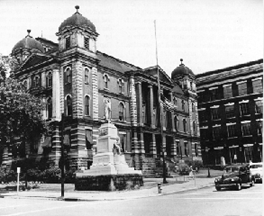
The second Wheeling Capitol
While awaiting the completion of a new capitol building in Wheeling, the facility housing the boy's school (established in 1814 by Wheeling lawyer Noah Linsly) was used a second time. The newly constructed facility was financed by the city of Wheeling, and when the seat of government was ultimately moved from there in 1885, the city found many uses for the stone structure both for municipal and county purposes. As the result of an election on a statewide basis, where the cities of Martinsburg, Clarksburg and Charleston received votes, in the fall of 1877 Governor Jacob issued a proclamation declaring that, after eight years, Charleston, having received the majority of the vote, was to be the permanent seat of government.
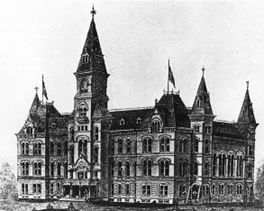
Artist's rendering of the second Charleston capitol
When the time for removal from Wheeling came, May 1, 1885, the state personages and properties embarked once again on steamers, the Chesapeake and the Bell Prince with the barge Nick Crawley in tow. The second Charleston capitol, and the fourth building used as the official home of the government, was erected on the same downtown site at a total cost of $389,923.58, including the cost of the building and grounds of the first Charleston capitol which had been transferred to the state by the State House Company. This building occupied a block in the city between Washington and Lee and Capitol and Dickinson Streets, was of brick and stone construction, and with the addition of the Capitol Annex several years later at the corner of Hale and Lee Streets, adequately served the needs and business of state government.
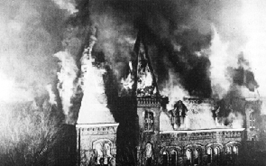
Burning of the picturesque downtown Charleston capitol,
January 1921
In the afternoon of January 3,1921, plumes of smoke were seen rising from the top of the capitol and soon thousands of spectators, including Governor Cornwell who emerged from a side door, witnessed the complete destruction of the picturesque vine-clad building with a clock tower. Many important records were saved for posterity because the State Law Library, the State Historical Library, the Archives and the State Museum were all housed in the Capitol Annex. Spectators viewing the burning were also treated to a rare display of fireworks, as thousands of rounds of ammunition, confiscated as a result of recent unrest in the coalfields, exploded and fueled the raging flames. Almost immediately plans were being formulated to rebuild a new capitol, the likes of which few people would imagine.
A temporary office building was speedily erected in forty-two working days after January 14, 1921, at a cost of $225,000, of wood and wallboard construction at the Daniel Boone Hotel site. That same year a State Capitol Commission was created during an extraordinary session of the Legislature when seven members were selected to choose an architect and find a 'suitable location for a complex of buildings of impressive structure which would serve the needs of state government in a practical sense for a long time to come'. The "Pasteboard Capitol" and other Charleston buildings would serve as temporary offices and houses for the state courts and Legislature for several years to come as the steps were carefully and decisively taken for the construction of a permanent and enduring monument to West Virginia's statehood.
« previous | next »